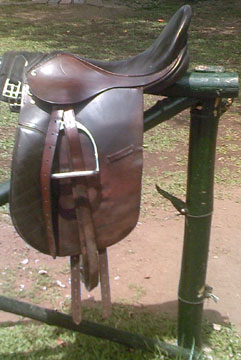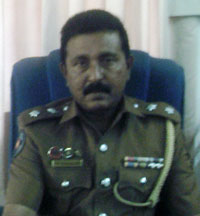Mounted guardians of the Law
by D.S Joseph
 It is a refreshing sight to see a police officer riding a horse
during peak hours of traffic in Colombo. The magnificent animal
manifests pomp and decorum. The Police Mounted Division is headquartered
in the Pettah. It is said that the horses were originally brought as
official transport for senior gazetted officers dacades ago. It is a refreshing sight to see a police officer riding a horse
during peak hours of traffic in Colombo. The magnificent animal
manifests pomp and decorum. The Police Mounted Division is headquartered
in the Pettah. It is said that the horses were originally brought as
official transport for senior gazetted officers dacades ago.
Horses have been associated with the military for centuries due to
their endurance and intelligence. They were part of British history even
before the medieval period; Stables were an important element in every
castle. In 1760, Sir John Fielding, a British Magistrate endorsed the
setting up of a Mounted Police unit to contain the menace of highway
robbers in London, who also fled on horseback! The first British patrol
had 8 riders.
The horse riding unit of the Ceylon Police was established in 1921. A
visit to the stables in the Pettah is awe inspiring. It is a serene
sanctuary. The incumbent Director of the Division is Assistant
Superintendent of Police Bamunuarachchi. The first building erected in
1920 still stands, with its arched ceilings, where the administrative
office functions. A glass showcase displays the various kinds of iron
horseshoes used in the decades gone by.
Priority
In 1956, the section was given priority and one Sub Inspector was
recruited along with two sergeants and 22 police constables. Inspector
Edward Gray became the first Ceylonese to head the Mounted Section.
Horses were initially imported from Australia. The majestic animals
serving presently are warm blood horses from the Netherlands who have
adapted well to the local weather. The warm blood horse is obtained by
breeding cold blood horses (Europe) with hot blood horses (Arabia).
Since the 1920s the Police stables extended to operate in the hills of
Kandy, salubrious
|

The saddle |
|

Inspector S.J.Kumarasiri |
Nuwara Eliya and the cradle of law enforcement training, the Police
College, Kalutara.
Proficiency
It is a proficiency level requirement that all officers on being
promoted to the rank of ASP be skilled equestrians.
During the visit of Her Majesty the Queen in 1954 the Mounted
Division was bestowed the honour of escorting her motorcade. During the
visit of a Head of State, the Mounties provide an escort with 24 horses.
At the annual Independence Day parades the horsemen uphold a
longstanding tradition by riding in their ceremonial white tunics
wearing sturdy pith helmets, carrying a wooden lance. Two of the
divisions notable commandants were the late SP Gamini Jayasighe (later
promoted DIG) and SP Ranmal Koddituwakku (presently DIG,). The incumbent
IGP PujithJayasundara is also a keen and competent rider.
Working police horses have a life span of 25 to 30 years. Their
height is measured by a unit known as 'hands'- a hand being equal to 4
inches. Larger horses stand at 15-17 hands. The animals require detailed
grooming and attention, especially, with regard to their food. As horses
cannot vomit, if they develop digestion issues it can cause colic, a
condition which can even lead to death. The horses are fed thrice a day
at 5 am, 11 am and 6 pm with a balanced mix of imported chaff, oats and
barley. After being exercised at the paddock (by riding) they receive a
bath from their keepers. The horses are sent on rotation for traffic
duty in teams comprising eight riders. When travelling outstation or for
a parade, the horses are transported in a long caravan-style vehicle
that can accommodate 9 animals in air-conditioned safety. The unique
vehicle has a cab with a bed for two officers.
Geldings
|

Keepers preparing food |
ASP Bamunuarachchi explains that some of the horses are geldings,
(horses that have been castrated) which make them have a calmer
temperament as they encounter crowds of people every day. The intricate
art of gelding is said to originate from the ancient Scythians, an
Iranian-Eurasian nomadic people who were very passionate about their
horses. The use of the horseshoe, which is nailed or glued into the
insensitive toe nail, is credited to the defiant Romans who excelled in
cavalry.
In countries such as Australia, England and America the mounted
police units have been successfully used to contain and repulse crowds
of demonstrators who disrupt traffic. Both, the animals and men wear
light weight body armour for safety. The sight of the galloping horses
is sufficient to break up the protesters. Regular police officers are
absorbed in the equestrian section and undergo six months of intense
training learning the finer points of horsemanship, including stable
management and veterinary care. All Mounties must obtain the certificate
of excellence before being endorsed to ride in uniform. Officer in
Charge of the Mounties, Inspector S.J.Kumarasiri tells me that the full
leather saddles are imported and each horse has its own fitted saddle
and bit, as wearing the wrong saddle can cause cuts and bruises which
will irritate and distract the animal. The riders are presently
practising their drills and show jumping routines for the 150th Police
Anniversary celebrations in September.
The Mounted division has a current operational strength of 46 horses
and 53 riders, supplemented by a workforce of dedicated horse-keepers.
These disciplined men combine their skills and experience as a motivated
team and continue to sustain the glorious history and decorum of the
division.
|

